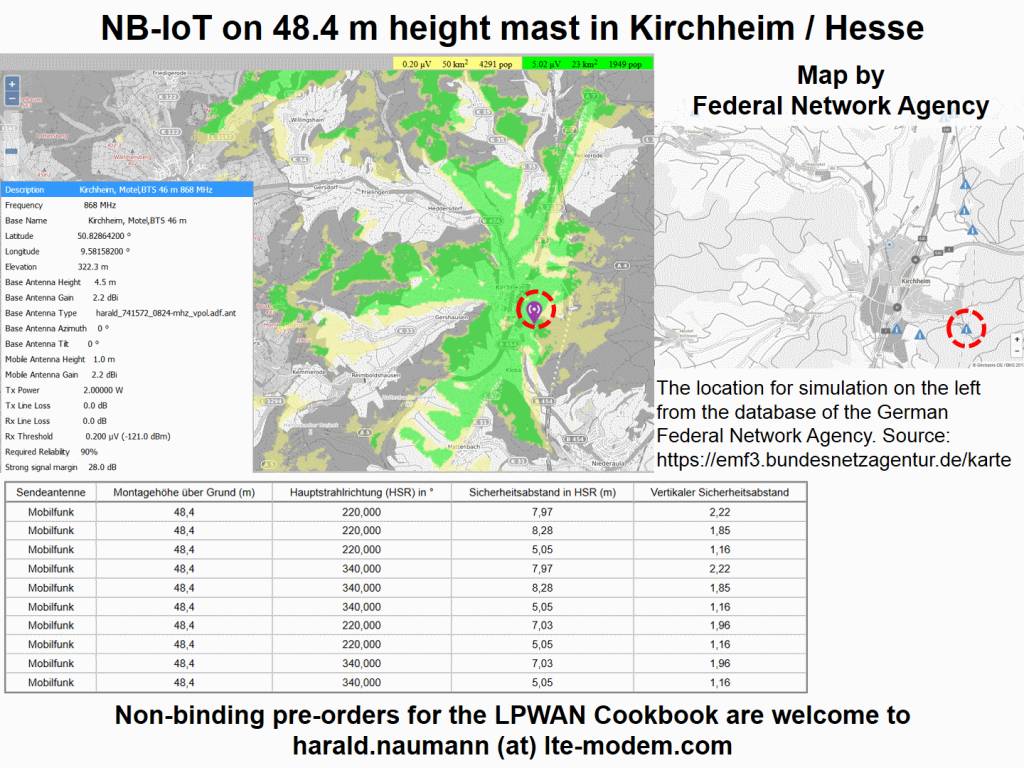The grey map with the blue triangles shows the cellular base stations in the Kirchheim area. This map is available online from the Federal Network Agency in Germany. In Germany the locations of the cellular base stations are publicly accessible for everybody. The base stations vary in height from about 5 m up to 48 m. In the simulation we simulated a 48 m mast on a hill 322 m in height above Kirchheim. Cellular radio systems generally consist of three sector antennas with an aperture angle of 120°. Three times 120° results in an omnidirectional radiation of 360°. To simplify the simulation, a spherical radiator with 2.15 dBi antenna gain was used. The sensitivity was set to -121 dBm and the transmit power to 2 W (33 dBm). 33 dBm plus -121 dBm results in a link budget of 154 dB. The maximum sensitivity of an NB-IoT module is -129 dBm. -119 dBm and thus 10 dB better corresponds to CE Level 1. -121 dBm is close to -119 dBm and was chosen because -121 dBm was used in the simulations for the private LPWAN in Kirchheim. -121 dBm should simplify the comparison between NB-IoT and LoRaWAN.
A quick NB-IoT CE Level explination
154 dB LB corresponds to Coverage Enhancement Level 1 (CE1). NB-IoT offers a maximum link budget of 164 dB for upload and download. However, the 164 dB figure is not the goal for network development, because at 164 dB the energy consumption of NB-IoT is high. NB-IoT has so-called Coverage Enhancement Levels (CE) 0, 1 and 2. 164 dB is called CE 2. 154 dB corresponds to CE 1 and 148 dB is called CE 0. With CE 1 and therefore 154 dB link budget, the energy consumption with NB-IoT is lower than with other LPWAN technologies. With CE 0 and therefore a link budget of 148 dB or better, NB-IoT reduces the transmission power again, resulting in even lower energy consumption.
NB-IoT coverage in Kirchheim
Due to the high standard location, a large part of Kirchheim is certainly well covered by 144 dB link budget. In addition, the 48 m high mast also supplies a long stretch of the motorway. Whether the supply is really so far reaching or even necessary we canot say, because the angle of inclination of the sector antennas is not known. With a tilt, for example, you can optimize the supply to the interior of the buildings in Kirchheim.
Private LPWAN for Kirchheim
To supply Kirchheim with a private LPWAN we need two LPWA gateways. Our possible locations are limited to the roofs of the houses with a gable height of approx. 5 to 6 meters. The cellular mast is about 42 m higher and on top of that on a high hill in Kirchheim. NB-IoT has technical advantages due to the high locations. The many triangles in the map of the Federal Network Agency show us that Kircheim is covered several times by cellular locations.
Note:
Hopefully I was able to stimulate a few ideas with this short article. Anyone who is really planning a private LPWAN for their town or community is welcome to contact me for a radio network planning. We are happy to share the knowledge for such a planning in a workshop. Participants at the workshop only need a basic knowledge of mathematics and should be familiar with the region for later planning. At the end of the workshop, our customer can perform the planning of the radio network himself. If required, the planning can be verified by our team.
Inquiries about workshops, consulting, development of LPWAN devices up to the development of customized, integrated antennas are welcome at harald.naumann(at)lte-modem.com.
